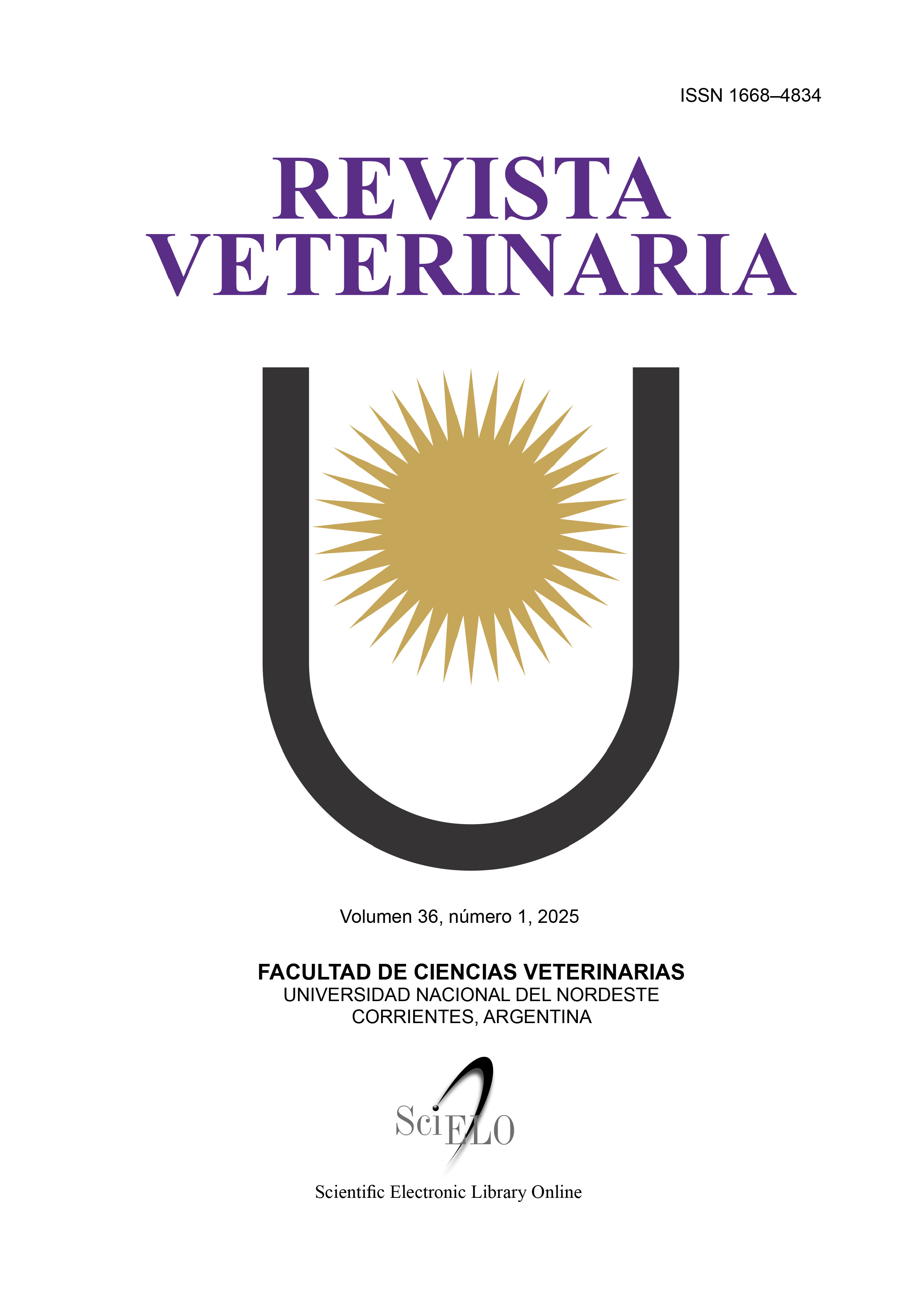Distribution of lymneids and cercaric index of Fasciola hepatica in the Arequipa Region, Peru
DOI:
https://doi.org/10.30972/vet.3628325Keywords:
Geographic location, Lymnaeidae, vector, infection, larvaeAbstract
Fasciolosis is a zoonotic disease caused by Fasciola hepatica, which is widely distributed in Peru and considered highly endemic in the Arequipa region. Despite this, records of lymnaeid snails in the area remain limited. This study aimed to identify lymnaeid vectors of F. hepatica and to determine their distribution across natural regions, along with their corresponding cercarial index (CI). Lymnaeid snails were manually collected from irrigation canals, wetlands, and other humid environments, identified by their small size and dextral coiling shell. A subset of 10–25 snails was immersed in water at 70°C for 30–40 seconds to facilitate soft tissue extraction. The soft bodies were then removed from the shells and preserved in 70% ethanol. Taxonomic identification was conducted at the Centre de Recherches insulaires et observatoire de L’environnement (CRIOBE), Université de Perpignan, France, based on morphological characteristics of the shell and soft body parts. Sampling locations were categorized according to natural regions: coast (≤2000 m.a.s.l.) and highlands (>2000 m.a.s.l.). Live lymnaeids were examined by compression under a compound microscope (40X and 100X magnification). The criterion for positivity was the presence of rediae and cercariae of F. hepatica. New distribution areas of lymnaeid snails were identified. On the coast, the species detected included Galba cubensis (primary vector) in the provinces of Caravelí, Camaná, Islay, and Arequipa; Pseudosuccinea columella (potential vector) in Caravelí; and G. schirazensis in Santa Rita de Siguas. In the highlands, G. truncatula was identified as the primary vector in the provinces of Caylloma, La Unión, Castilla, Condesuyos, and Arequipa. Cercarial indices were generally low, averaging 0.63% for the Arequipa region. In localities with positive vectors, the distribution was as follows: on the coast, G. cubensis in Vítor showed a CI of 2.13%; in the highlands, G. truncatula exhibited CI values of 1.20% in Huanca, 1.61% in Achoma, 2.63% in Maca, and 2.78% in Taurisma.
Downloads
References
Alba A, Vázquez AA, Sánchez J, Gourbal B. Immunological resistance of Pseudosuccinea columella snails from Cuba to Fasciola hepatica (tremátoda) infection: what we know and where we go on comparative molecular and mechanistic immunobiology, ecology and evolution. Front. Immunol. 2022; 13:794186.
Alda P, Lounnas M, Vázquez AA, Ayaqui R, Calvopiña M, Celi-Erazo M, Dillon RT, Jarne P, Loker ES, Muñiz FC, Muzzio-Aroca J, Nárvaez AO, Noya O, Robles LM, Rodríguez-Hidalgo R, Uribe N, David P, Pointier JP, Hurtrez-Boussès S. A new multiplex PCR assay to distinguish among three cryptic Galba species, intermediate hosts of Fasciola hepatica. Vet Parasitol. 2018; 251:101-105.
Alda P, Lounnas M, Vázquez AA, Ayaqui R, Calvopiña M, Celi-Erazo M, Dillon RT, Gonzales LC, Loker E, Muzzio-Aroca J, Nárvaez AO, Noya O, Pereyra AE, Robles LM, Rodríguez-Hidalgo R, Uribe N, David P, Jarne P, Pointier JP, Hurtrez-Boussès S. Systematics and geographical distribution of Galba species, a group of cryptic and worldwide freshwater snails. Molecular Phylogenetics and Evolution. 2021; 157: 107035.
Ayaqui R. Presencia de Lymnaea truncatula y Pseudosuccinea columella en la región Arequipa, Perú. Libro de Resúmenes del XXIV Congreso Latinoamericano de parasitología, Santiago, Chile. Revista de parasitología Latinoamericana, 2017; 66(3):76-77. Versión on-line ISSN: 0719-6326.
Ayaqui R, Ruelas-Llerena N, Ticona J, Zamata-Ramos M, Condo R, Ancco-Valdivia F. Prevalencia y factores de riesgo de la fasciolosis en ganado bovino de la región Arequipa, Perú, 2021. Rev. vet. 2024; 35(1): 29-37.
Bardales-Valdivia JN, Bargues MD, Hoban-Vergara C, Bardales-Bardales C, Goicochea-Portal C, Bazán-Zurita H, Del Valle-Mendoza J, Ortiz P, Mas-Coma S. Spread of the fascioliasis endemic área assessed by seasonal follow-up of rDNA ITS-2 sequenced lymnaeid populations in Cajamarca, Perú. One Health. 2021; 13:100265
Bargues MD, Artigas P, Khoubbane M, Ortiz P, Náquira C, Mas-Coma S. Molecular characterisation of Galba truncatula, Lymnaea neotropica and L. schirazensis from Cajamarca, Perú and their potential role in transmission of human and animal fascioliasis. Parasit Vectors. 2012; 5: 174.
Bargues MD, Artigas P, Angles R, Osca D, Duran P, Buchon P, Gonzales-Pomar RK, Pinto-Mendieta J, Mas-Coma S. Genetic uniformity, geographical spread and anthropogenic habitat modifications of lymnaeid vectors found in a One Health initiative in the highest human fascioliasis hyperendemic of the Bolivian Altiplano. Parasit Vectors. 2020; 613(1): 171.
Caron Y, Celi-Erazo M, Hurtrez-Boussès S, Lounnas M, Pointier JP, Saegerman C, Loson B, Benítez-Ortiz W. Is Galba schirazensis (Mollusca, Gastropoda) an intermediate host of Fasciola hepatica (Trematoda, Digenea) in Ecuador? Parasite. 2017; 24(24): 1-9.
Celi-Erazo M, Alda P, Montenegro M, Pavón D, Minda A, Calvopiña M, Pointier JP, Hurtrez-Bousses S, Cevallos W, Benítez W, Rodríguez-Hidalgo R. Prevalence of Fasciola hepatica infection in Galba cousini and Galba schirazensis from an Andean region of Ecuador. Veterinary Parasitology: Regional Studies and Reports. 2020; 20: 100390.
Chávez-Arce E, Zumarán G. Frecuencia de fascioliasis en ganado y de Fasciola hepatica en caracoles Lymnaeidae en el distrito de Huanca, Arequipa, Perú. Rev. Inv. Vet. Perú. 2021; 32(3): e17607.
Coelho L, Lima W. Population dynamics of Pseudosuccinea columella and its natural infection by Fasciola hepatica in the State of Minas Gerais, Brazil. J. Helminthology. 2003; 77 (1):7-10.
De Vargas M, Martínez J, Castillo J, Paulino D, Alarcón-Elbal P, Vázquez A. Potencialidad de Pseudosuccinea columella (Say, 1817) (Mollusca: Gastropoda: Lymnaeidae) en la transmisión de la fascioliasis humana en República Dominicana. Ciencia y Salud. 2019; 3(2): 9-16.
Fundacionio. Diciembre 2020. Fasciolosis en Arequipa, Perú. 2020, P. 1. Disponible en: https://fundacionio.com/diciembre-2020-fascioliasis-en-arequipa-peru/. Ultimo acceso 06-02-2025
Gobierno Regional de Arequipa (GRA). Plan de desarrollo regional concertado 2013 - 2021 actualizado de la región Arequipa. 2016. Disponible en: https://www.saludarequipa.gob.pe/transp/planeamiento/PDRC%202013-2021.pdf. Ultimo acceso 06-02-2025.
Jara-Campos C, Escalante-Añorga, H, Siancas-Ruíz F, Casana-Mantilla, W, Benites-Murrieta, A. Infección de Lymnaea por Fasciola hepatica (Linnaeus, 1758) en la provincia de Pataz, Perú e identificación de plantas asociadas a sus biotopos. Neotropical Helminthology. 2019; 13(2): 123-133.
Larrea H, Vivar R, Oviedo ML, Huaman P, Pachas L. Tres estudios de la familia Lymnaeidae vectores de la fasciolosis en el Perú. Bol. de Lima.1993; 89: 85-96.
Manrique J, Cuadros S. Fasciolosis: Buscando estrategias de control. 1ra edición, Edit. Akuarella, Arequipa. 2002. p. 68.
Mas-Coma S, Funatsu IR, Bargues MD. Fasciola hepatica and lymnaeid snails occurring at very high altitude in South America. Parasitology. 2001; 123: 115-127.
Mas-Coma S, Valero MA, Bargues MD. Climate change effects on trematodiases, with emphasis on zoonotic fascioliasis and schistosomiasis. Vet. Parasitol. 2009; 163(4): 264-280.
May R, Anderson R. Population biology of infectious diseases: Part II. Nature. 1979; 280: 455-461.
Moriena R, Alvarez J, Pietrokovsky S, Rubel D, Prepelitchi L, Racioppi O, Wisnivesky C. Presencia de pseudosuccinea columella naturalmente infestada con Fasciola hepatica en Santo Tomé (Corrientes, Argentina). Rev. vet. 2008; 19(2): 147-149.
Pereira AE, Uribe N, Pointier JP. Lymnaeidae from Santander and bordering departments of Colombia: Morphological characterization, molecular identification and natural infection with Fasciola hepatica. Vet. Parasitol.: Reg. Stud. Rep. 2020; 20: 100408.
Pointier JP, Cazzaniga N, González-Salas C, Gutiérrez A, Arenas J, Bargues MD, Mas-Coma S. Anatomical studies of sibiling species within neotropical lymnaeids, snail intermediate host of fasciolasis. Mem. Inst. Oswaldo Cruz, Rio de Janeiro. 2006; 101(4): 431-435.
Pointier JP, Vázquez AA. Lymnaeoidea, Lymnaeidae. In: Thorp & Covich’s Freshwater invertebrates, Cristina Damborenea, D. Christopher Rogers & James H. Thorp Eds. Springer. 2020; 281-290.
Ríos-Granizo J, Villavicencio-Abril A, Guamán-Guamán R, Ulloa-Cortázar S, Medina-Suescún E. Prevalencia e identificación de moluscos lymneidos transmisores de Fasciola hepatica Linnaeus, 1758 (Platyhelminthes, Trematoda), en la Comunidad San Martín de la Parroquia Columbe, Cantón Colta, Provincia De Chimborazo, Ecuador. Neotrop. Helminthol. 2021; 15(1): 1-13.
Supo J. Metodología de la investigación científica, 3ra edición, Edit. Bioestadístico EEDU EIRL USA, Columbia. 2020. P 23-24, 180-181.
Vázquez A, Sánchez J, Jiménez Y. Distribución y preferencia de hábitats de moluscos hospederos intermediarios de Fasciola hepatica en Cuba. Revista Cubana de Medicina Tropical. 2009; 61: 248-263.
Vázquez A, Sánchez J, Alba A, Pointier JP, Hurtrez-Bousses S. Natural prevalence in Cuban populations of the lymnaeid snail Galba cubensis infected with the liver fluke Fasciola hepatica: Small values do matter. Parasitol Res. 2015; 114(11): 4205-10.
Vázquez A, De Vargas M, Sánchez J, Alba A, Sabourin E, Vittecoq M, Alarcon-Elbal PM, Pointier JP, Hurtrez-Bousses S. Reviewing Fasciola hepatica transmission in the west indies and novel perceptions from experimental infections of sympatric vs. allopatric snail/fluke combinations. Vet Parasitol. 2019; 275: 108955.
Downloads
Published
How to Cite
Issue
Section
License

This work is licensed under a Creative Commons Attribution-NonCommercial 4.0 International License.
Revista Veterinaria (Rev. Vet.) maintains a commitment to the policies of Open Access to scientific information, as it considers that both scientific publications as well as research investigations funded by public resources should circulate freely without restrictions. Revista Veterinaria (Rev. Vet.) ratifies the Open Access model in which scientific publications are made freely available at no cost online.











.jpg)
.jpg)



